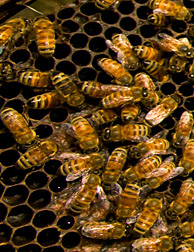User talk:Engelbrechte: Difference between revisions
Engelbrechte (talk | contribs) |
Engelbrechte (talk | contribs) |
||
| Line 15: | Line 15: | ||
==Genome Structure== | ==Genome Structure== | ||
<The genome of SINV-1 includes a 5' UTR, two ORFs, a 3' UTR and poly A tail (as determined by Rapid Amplification of cDNA Ends). ORF1 encodes helicase, cysteine protease, and RdRp. ORF2 encodes capsid proteins. RdRp homology with KBV (Kashmir bee virus), Acute bee paralysis virus (ABPV), and Taura syndrome virus | <The monopartite genome of SINV-1 consists of (+) ssRNA (accession number AY634314) and includes a 5' UTR, two ORFs, a 3' UTR and poly A tail (as determined by Rapid Amplification of cDNA Ends). ORF1 encodes helicase, cysteine protease, and RNA-dependent RNA polymerase (RdRp). ORF2 encodes capsid proteins. SINV-1 RdRp is exhibits homology with KBV (Kashmir bee virus), Acute bee paralysis virus (ABPV), and Taura syndrome virus. | ||
> | |||
It has been reported that integration of (+) ssRNA viral genomes into the host genome may afford "protection to the host by the corresponding virus." Because researchers want to exploit SINV-1 as a lethal S. invicta pathogen, it was important to determine if the viral genome is incorporated into that of the host. In a 2004 study using 32 S. invicta genomic DNA samples, researchers did not detect integration of SINV-1 into the host genome.> | |||
==Virion Structure of a ______virus== | ==Virion Structure of a ______virus== | ||
Revision as of 20:49, 16 September 2012
Solenopsis invicta virus 1 (SINV-1, SINV2, SINV-3)
A Viral Biorealm page on the family Engelbrechte

Baltimore Classification
<Viruses; (+) ssRNA virus, Dicistroviridae>
Higher order categories
Description and Significance
Genome Structure
<The monopartite genome of SINV-1 consists of (+) ssRNA (accession number AY634314) and includes a 5' UTR, two ORFs, a 3' UTR and poly A tail (as determined by Rapid Amplification of cDNA Ends). ORF1 encodes helicase, cysteine protease, and RNA-dependent RNA polymerase (RdRp). ORF2 encodes capsid proteins. SINV-1 RdRp is exhibits homology with KBV (Kashmir bee virus), Acute bee paralysis virus (ABPV), and Taura syndrome virus.
It has been reported that integration of (+) ssRNA viral genomes into the host genome may afford "protection to the host by the corresponding virus." Because researchers want to exploit SINV-1 as a lethal S. invicta pathogen, it was important to determine if the viral genome is incorporated into that of the host. In a 2004 study using 32 S. invicta genomic DNA samples, researchers did not detect integration of SINV-1 into the host genome.>
Virion Structure of a ______virus
Reproductive Cycle of a ______virus in a Host Cell
<While the surface protein(s) that SINV-1 binds are unknown, electron microscopy of S. invicta workers and larval gut revealed the presence of SINV-1 virus particles with a diameter of 30-35 nm. >
Viral Ecology & Pathology
<Late-instar S. invicta digest all solid food for the colony and redistribute it as liquid to nestmates. In this way, larvae serve as both a replication site and passage fir SINV-1 colonial propagation. Experiments using Real-time PCR demonstrate that SINV-1 exists primarily in the midgut of S. invicta, evidence of the horizontal fecal-oral route of viral infection. SINV-1 detection in "all developmental stages of S. invicta including eggs and queen" indicates vertical transmission of the virus. SINV-1 infected S. invicta populations are asymptomatic, but their ability to compete with uninfected ants of their own and other species is reduced. Some environmental stresses induce symptoms or even death in SINV-1 infected ants. In the laboratory, SINV-1 infection was associated with larval mortality. These observations highlight the complexity of microscopic mutualisms in nature. The goal of SINV research is to exploit these viruses so they can effectively wipe out populations of the imported red fire ant. Proposed methods include using the virus to deliver a toxin or an RNAi sequence to kill its host. >
References
Example:
Weir, Jerry P. " Genomic Organization and Evolution of the Human Herpesviruses." Virus Genes 16.1 (1998): 85-93.
Page authored for BIOL 375 Virology, September 2010
